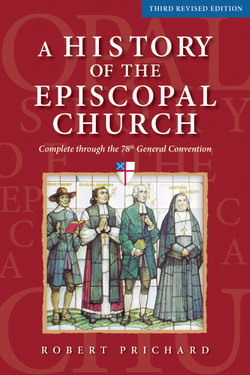Читать книгу A History of the Episcopal Church (Third Revised Edition) - Robert W. Prichard - Страница 8
На сайте Литреса книга снята с продажи.
ОглавлениеPreface to theThird Edition
Those who are acquainted with the two prevision editions of this work will see much in it that is familiar. For major portions of the book, the narrative remains unchanged. Yet there are, however, some significant differences. These differences are the results of five factors: incorporation of the insights of new scholarship, the extension of the narrative to include the fifteen years since the publication of the last edition, adoption of some new conventions about terminology, the correction of errors, and the inclusion of information excluded from the earlier edition that subsequent years of teaching have shown to be of interest to students of the history of the Episcopal Church.
Most of the new scholarship that I have sought to incorporate concerns the English Reformation, the institution of slavery, the state of Christianity in the eighteenth century, the American Civil War, and the creation of Anglican Communion in the nineteenth century. In most cases readers will have to refer to the notes to see the new sources on which I have relied.
The years from 1999 to 2014 have been important ones for the Episcopal Church, a period that includes important ecumenical agreements, the election of the first woman as presiding bishop, the consecration of the first openly gay bishop, a major schism, and growing tension in the Anglican Communion. I appreciate the opportunity given to me by Church Publishing to extend the narrative to include these elements.
The two major places in which I have adopted new terminology concern the succession of bishops and the language used to identify members of the colonial Church of England. I have adopted the language used in recent ecumenical discussions and referred to continuity in ordinations running back to the early church as “episcopal succession,” rather than “apostolic tradition” or “apostolic succession.” The latter terms are used in contemporary ecumenical discussions to refer broadly to all that is handed down from the early church—teaching, preaching, worship, ordained ministry, social action—and not just to forms of ministry imparted by the laying on of hands by bishops. I also have referred to the members of the colonial church as members of the “Church of England,” reserving the term Anglican for the mid-nineteenth century and thereafter, when the term was actually in use.
Readers of earlier editions of this book have been generous with their time and have pointed to errors, which I have attempted to correct in this edition. In previous editions, for example, I incorrectly identified the parish of the first candidate for the episcopate elected in Virginia and misunderstood the lay status of Charles Miller of King’s Chapel. I hope that readers of this current edition will be equally kind in pointing to places in which the text can be improved.
Finally, I have included some information in this book of which I was aware at the time of earlier editions but which I doubted would be of general interest. My experience of teaching of the past fifteen years has led to new insights about what information is useful. I have been long aware, for example, that the 1662 English Book of Common Prayer—the edition used for the majority of the colonial period—included a rubrical change that allowed reception of communion by a person who was “ready and desirous” of confirmation but not actually confirmed. That provision made it possible for colonial Anglicans, who lacked any resident bishops, to receive communion. What I was not aware at the time of the last edition was how this piece of information, which I assumed to be widely known, came as a surprise to many, including some who write about the colonial Church of England. In a similar way, I have expanded information about Episcopal canon law, a topic that recent rounds of litigation have apparently made more interesting to current students of the Episcopal Church.
I want to confess to one idiosyncrasy on my part. In the early part of the twenty-first century, it became common for some editors and authors writing about the Episcopal Church to capitalize the initial article (The Episcopal Church). There is no doubt a complicated explanation for this practice of which I am not aware, but lacking that knowledge, I will follow the simple rules of English grammar and leave the article in lowercase within running text.1
Robert W. Prichard
Virginia Theological Seminary
June, 2014
